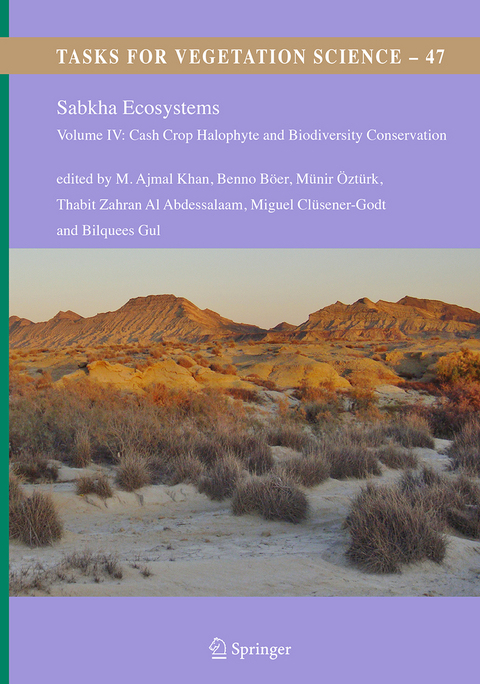
Sabkha Ecosystems
Springer (Verlag)
978-94-024-0640-5 (ISBN)
List of Authors.- Preface.- Foreword.- Acknowledgements.- Introduction.- 1. Economic sustainability for halophyte cash farms in urban environments.- 2. Spatial distribution of soil salinity and its management options in the Northern Emirates, UAE.- 3. Gypsum crystals formation and habits, Umm Said sabkha, Qatar.- 4. Distribution, ecology and ecophysiology of mangroves in Pakistan.- 5. Halophytes for the production of liquid biofuels.- 6. Feasibility of halophyte domestication for high-salinity agriculture.- 7. The gypsum dunes of Cuatrociénegas Valley, Mexico – A secondary Sabkha ecosystem with gypsophytes.- 8. Effects of seed storage on germination of desert halophytes with transient seed bank.- 9. Halophytes of southwest Asia.- 10. From halophyte research to halophytes farming.- 11. Interactive effect of salinity and drought on the germination of dimorphic seeds of Suaeda salsa.- 12. Kochia (Kochia scoparia (L.) Schrad) unwanted or wanted plant for forage production in harsh environments.- 13. Importance of the diversity in between halophytes to agriculture and land management in arid and semiarid countries.- 14. Is soil heterogeneity the major factor influencing vegetation zonation at Karachi coast?.- 15. Research and development with seawater and halophytic plants for sustainable saline agro systems in the Arabian Gulf.- 16. Salinity tolerant turfgrasses for biosaline urban landscape agriculture.- 17. Ecology, distribution and ecophysiology of Salicornia Europaea L..- 18. Germination pre-treatments in Haloxylon persicum (Amaranthaceae), an economically important tree of desert ecosystems in western Asia.- 19. Halophytes in the east Mediterranean – their medicinal and other economical values.- 20. Germination and early seedling growth of two salt-tolerant Atriplex species that prevent erosion in Iranian deserts.- 21. Salt marshes and biodiversity.- 22. Distinctive features and role of sulfur-containing compounds inmarine plants, seaweeds, seagrasses and halophytes from an evolutionary point of view.- 23. The chemical composition and technological properties of seagrasses – a basis for their use (a review).- 24. Seagrass terraces for food security and carbon sequestration.- 25. Floating mangroves: the solution to reduce atmospheric carbon levels and land-based marine pollution?.- 26. World Halophyte Garden: Economic dividends with global significance.- Index.
| Erscheinungsdatum | 14.10.2016 |
|---|---|
| Reihe/Serie | Tasks for Vegetation Science ; 47 |
| Zusatzinfo | 121 Illustrations, black and white; XXIII, 339 p. 121 illus. |
| Verlagsort | Dordrecht |
| Sprache | englisch |
| Maße | 178 x 254 mm |
| Themenwelt | Naturwissenschaften ► Biologie ► Ökologie / Naturschutz |
| Naturwissenschaften ► Geowissenschaften | |
| Sozialwissenschaften ► Pädagogik | |
| Technik ► Elektrotechnik / Energietechnik | |
| ISBN-10 | 94-024-0640-9 / 9402406409 |
| ISBN-13 | 978-94-024-0640-5 / 9789402406405 |
| Zustand | Neuware |
| Haben Sie eine Frage zum Produkt? |
aus dem Bereich


